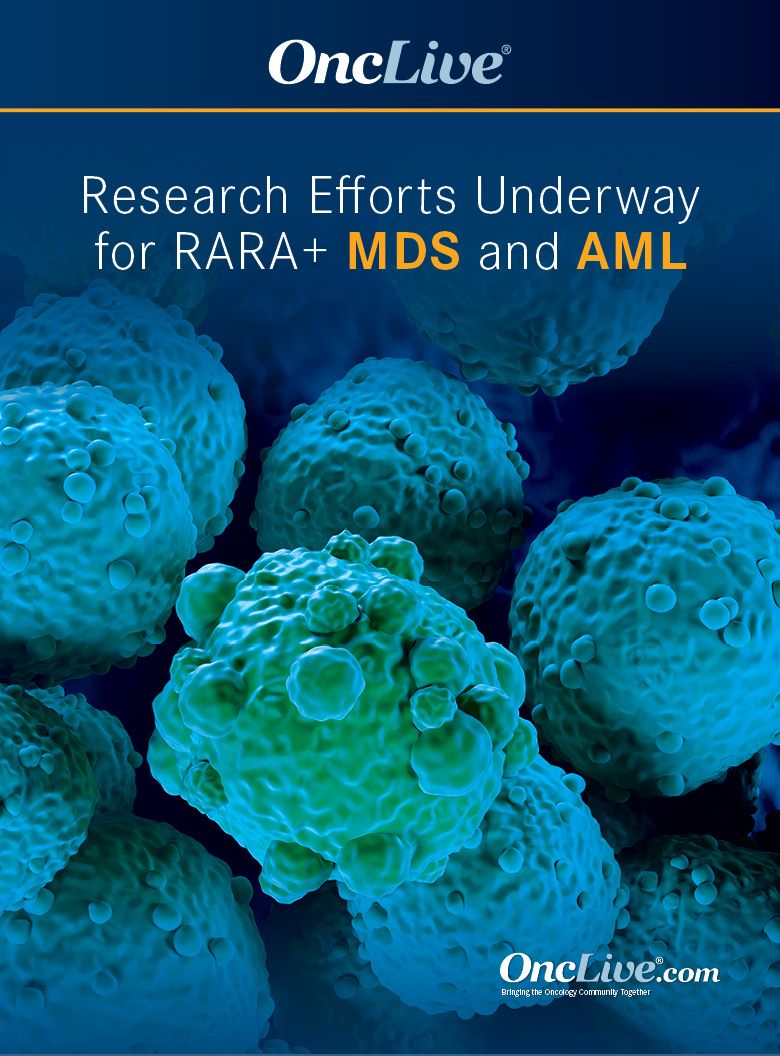Publication
Article
Tamibarotene Combinations Under Investigation in Newly Diagnosed AML and MDS
Author(s):
Gautam Borthakur, MD, discussed the rationale for targeting RARA-overexpressing AML, the potential efficacy and safety benefits of tamibarotene, and how SELECT AML-1 and SELECT MDS-1 could change the respective treatment landscapes in AML and MDS.
Gautam Borthakur, MD

The oral selective retinoic acid receptor alpha (RARA) agonist tamibarotene may increase the efficacy of standard azacitidine (Vidaza) plus venetoclax (Venclexta) in patients with acute myeloid leukemia (AML) without causing added myelosuppression, according to Gautam Borthakur, MD.1
In the phase 2 SY-1425-201 trial (NCT02807558), treatment with tamibarotene plus azacitidine led to an overall response rate of 67% in patients with RARA-positive AML vs 39% in those with RARA-negative AML.1The ongoing phase 2 SELECT AML-1 (NCT04905407) trial is evaluating the triplet combination of tamibarotene, azacitidine, and venetoclax in patients with newly diagnosed AML with RARA overexpression, and the ongoing phase 3 SELECT MDS-1 trial (NCT04797780) is evaluating tamibarotene plus azacitidine in patients with newly diagnosed myelodysplastic syndrome (MDS) with RARA overexpression.2,3
“Because venetoclax is the backbone for treating older patients with AML, we’re using the backbone of azacitidine and venetoclax and comparing that with the triplet combination to see if we can make a difference, particularly in the subgroup of patients [with AML] that overexpresses RARA,” Borthakur said.
In an interview with OncLive®, Borthakur discussed the rationale for targeting RARA-overexpressing AML, the potential efficacy and safety benefits of tamibarotene, and how SELECT AML-1 and SELECT MDS-1 could change the respective treatment landscapes in AML and MDS.
Borthakur is a professor in the Department of Leukemia in the Division of Cancer Medicine at The University of Texas MD Anderson Cancer Center in Houston.
OncLive: What emerging AML and MDS therapies are important to note?
Borthakur: In AML in the past 4 or 5 years, the most excitement has come from the addition of venetoclax, a BCL-2 inhibitor, to frontline treatment, particularly in the older patient population. At MD Anderson, we have also generated a good amount of data that [venetoclax] can be combined with intensive chemotherapy, for younger patients also, and have great results. The remission rates are higher, and the responses are deeper and are lasting longer.
Now, the question is: Where do we go next? For certain subsets of patients, we are still struggling. Most of these [patients are] the high-risk group defined by the 2017 or 2022 European LeukemiaNet classifications. Most of [their diseases] are driven [by] p53 mutations, complex cytogenetics, RUNX1 mutations, [and other] high-risk mutations. Those are the groups where we are still struggling to make a significant dent.
Another group that has become interesting in the past few years is [patients with] monocytic AML. Patients treated with azacitidine plus venetoclax or any hypomethylating agent [HMA] plus venetoclax are either refractory to treatment or [have] shorter responses. We’re not seeing the survival benefit that we have seen with azacitidine and venetoclax [in other patient subsets]. We’re trying to understand the biology.
One biology that emerged from the lab of Ravi Majeti, MD, PhD, of Stanford University, showed that some subsets of AML have RARA overexpression. RARA has been a great target for the treatment of acute promyelocytic leukemia [APL] through all-trans retinoic acid [ATRA] and has revolutionized treatment. Some oral versions of retinoic acid analogs are also approved in other countries for APL. There, we have made a humongous difference.
But the Majeti lab showed that in some of these patients, there is an overexpression of RARA driven by the super enhancer complex, which drives the exploration of many oncogenes. These complexes are remodeled in cancer, [including] in AML. This remodeling of the super enhancer complex that drives RARA expression is the mechanism by which RARA is overexpressed in these patients with AML.
Interestingly, monocytic AML somewhat coincides with that. On one hand, we have a problem with monocytic AML, where there is increased resistance to venetoclax-based treatment. On the other hand, we have this population of monocytic AML that also overexpresses RARA. That was the rationale behind adding tamibarotene to the treatment of patients with AML overexpressing RARA.
The initial study with azacitidine plus tamibarotene was promising. [Going forward, SELECT AML-1 is] a biomarker-driven study. We are selecting a patient population where we expect outcomes will be inferior with azacitidine and venetoclax [and asking]: Can we make these [outcomes] better? This is a significant unmet need [that this research is] addressing.
What is the mechanism of action of tamibarotene, and how did this contribute to the rationale to investigate it in AML and MDS?
An oral version of an ATRA has been a dream for many of us, because the advantage of a good ATRA, particularly if we can incorporate it into frontline treatment for AML, is that we can start thinking of an all-oral AML treatment. Oral versions of the HMAs decitabine and azacitidine are now in the clinic and are approved in different settings. Venetoclax is oral. Now, can we think of a situation where we can [create an] all-oral treatment for AML? That will be the next development in AML, and possibly in MDS also.
Tamibarotene is well tolerated. When it was tested in combination with azacitidine, there were no true additional toxicities seen. That makes it unique. [Additionally], when adding a third agent to a backbone of azacitidine and venetoclax, the bigger worry is: Will we create more myelosuppression? [Will] the bone marrow not recover? Are we adding toxicity to the bone marrow? [Tamibarotene] is a differentiation-inducing agent, so we’re not expecting additional marrow suppression.
[In summary, the triplet is] all oral, does not add additional myelosuppression, and potentially targets a high-risk group. That’s a nice concept and will hopefully translate out.
What early efficacy data have been seen with tamibarotene plus azacitidine in the SY-1425-201 trial in patients with AML?
The efficacy was better than what we would historically expect with azacitidine. A subset analysis [showed] that [patients with AML] with monocytic features or overexpression of RARA benefited. There is scientific underpinning to the concept. Now, a randomized trial will need to prove that.
What are the key eligibility criteria for the SELECT AML-1 trial?
[SELECT AML-1 is enrolling] newly diagnosed patients with AML. [These patients need to have] biomarker positivity, [as this trial is enrolling a] patient population that overexpresses RARA. In general, the monocytic group may overexpress RARA, but that may not always be the case. There may be non-monocytic AMLs that can overexpress RARA, and some monocytic AMLs may not overexpress RARA.
[These eligibility criteria are] biomarker driven in a select population. This biomarker selection [is under a bit of pressure] because there is a turnaround time for testing. There is some urgency to treat patients with newly diagnosed AML. However, this trial has made that relatively easier because at least we can start the azacitidine and venetoclax combination while we wait for the biomarker expression data. That helps because at least we are not depriving a patient of frontline and timely treatment. Functionally, that has made [this regimen] efficient without compromising patient care.
What are some of the challenges of making SELECT AML-1 and SELECT MDS-1 biomarker-driven trials?
[One challenge is the] turnaround time for the biomarker [testing]. Now, it’s down to about 4 or 5 days. That’s acceptable, because many times, even for our patients with AML, at most centers we wait for about 48 to 72 hours to get the mutation profile back for at least the targetable mutations FLT3, IDH1, and IDH2.
In that context, a 5-day turnaround for RARA is not bad because if a patient does not have a targetable mutation, say a FLT3 mutation, in most of these patients, the standard of care would be azacitidine and venetoclax, so at least we can start the treatment, wait for the RARA expression data, and then if the patient is RARA positive, [we can] randomize them to [treatment in] the trial. That has become much better. As we get used to a process and make it more efficient, there is always a bit of time lag. However, we have overcome that, and now the time required to complete the testing for RARA [and other biomarkers is shorter]. We are in a good place.
How do the design and eligibility criteria of SELECT MDS-1 compare with those of SELECT-AML 1?
[This trial is] not particularly different. This trial has a good chance of [affecting the MDS treatment landscape] because for patients with MDS, for several years, we have not moved beyond HMAs. Trials are ongoing with venetoclax [and other agents], and we’ll see whether those make a difference.
However, there’s still much room for improvement in MDS. Particularly, patients who progress on HMAs do poorly. The idea is to make an improvement in the frontline setting so fewer patients progress on treatments. This is taking the same concept that’s prevalent in AML [and using it in] MDS. Hopefully, that will translate to an improved outcome.
Taking corollary from AML, these may be patients who do not benefit from venetoclax. That’s to be proven. In AML, at least we know that monocytic subsets don’t do well with venetoclax. But in MDS, we don’t have solid data for that yet. However similar ideas [may] apply. Any improvement over HMAs alone in MDS could be important because for the past 7 or 8 years, barring the therapies [targeting mutations like] IDH1, IDH2, and FLT3, we have not made a huge dent for patients with MDS.
How could the SELECT AML-1 and SELECT MDS-1 trials, among other studies building on the azacitidine/venetoclax backbone, address more unmet needs within AML and MDS?
Triplets are challenging. Most of the challenge from triplets comes from added myelosuppression. Some drug interaction issues also exist because some drug-drug interactions can increase or decrease the levels of venetoclax [and other agents].
Drugs that do not add to the toxicity are most important for the success of the triplets in AML. Knowing the mechanism of action of RARA inhibition and tamibarotene, we’re not expecting additional myelosuppression [with this agent]. We have not seen that in the doublet trials that have been done. That will be exciting if it pans out because with triplet combinations, specialized centers have enough expertise to fine-tune the treatments to avoid excessive myelotoxicity or bone marrow suppression.
We want these treatments, particularly all oral treatments, to be available at a much wider level. It’s important to have triplet combinations where we don’t expect additional bone marrow toxicity or other toxicities. That’s how tamibarotene is bringing excitement to the field.
What outcomes from SELECT AML-1 and SELECT MDS-1 will be most important to watch for?
The question is: What outcomes will be the most relevant? The remission rates are relevant. The bigger relevance would be event-free survival [EFS], which hopefully would eventually translate to overall survival [OS]. Those are the data we’ll need to wait for. Hopefully [we will also see] deeper molecular remissions, where patients who go for transplant go [after] deeper responses, so their post-transplant outcomes are also better. I’m hoping that at least in this shorter timeframe, we see an effect on EFS and in the longer timeframe, we see an effect on OS.
References
- De Botton S, Cluzeau T, Vigil CE, et al. SY-1425, a potent and selective RARα agonist, in combination with azacitidine demonstrates a high complete response rate and a rapid onset of response in RARA-positive newly diagnosed unfit acute myeloid leukemia. Blood. 2020;136(suppl 1):4-5. doi:10.1182/blood-2020-134600
- Tamibarotene plus venetoclax/azacitidine in participants with newly diagnosed AML. ClinicalTrials.gov. Updated February 27, 2023. Accessed April 3, 2023. https://clinicaltrials.gov/ct2/show/NCT04905407
- Tamibarotene plus azacitidine in participants with newly diagnosed RARA-positive higher-risk myelodysplastic syndrome. Updated February 27, 2023. Accessed April 3, 2023. https://clinicaltrials.gov/ct2/show/NCT04797780










